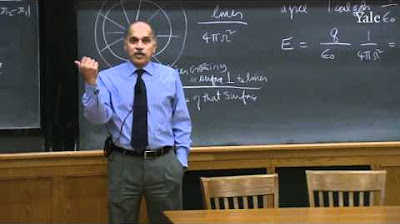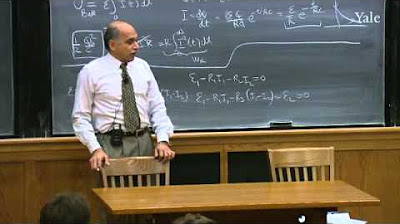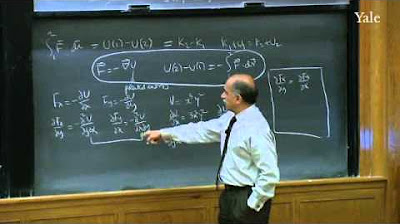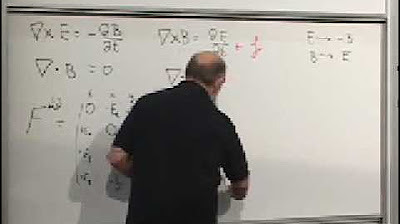1. Electrostatics
TLDRThe transcript is a detailed lecture on electromagnetism, optics, and quantum mechanics, with a focus on the fundamental principles of force, mass, and acceleration as described by Newton's laws. The professor emphasizes the importance of understanding dynamics and introduces the concept of electromagnetic force, highlighting its significant strength compared to gravity, demonstrated through an experiment with a comb and paper. Coulomb's Law is discussed as the governing principle for electrostatic interactions, with the lecturer delving into the conservation and quantization of charge. The lecture also explores the microscopic perspective of atoms, electrons, and protons, and their roles in electric charge. The professor concludes with a discussion on the calculation of forces in electrostatics, particularly when dealing with continuous charges such as a charged ring, and the importance of testing results for accuracy.
Takeaways
- 📘 The syllabus for the term includes electromagnetism, optics (a part of electromagnetism), and quantum mechanics, which is a fundamentally different concept focusing on the behavior of particles at the atomic and subatomic levels.
- 🧲 Electromagnetism will be introduced as a new force, with a focus on how it affects the motion of objects, and optics will be studied as a part of this force.
- ⚛️ Quantum mechanics challenges traditional concepts like trajectories and is essential for studying very small entities such as atoms and molecules, although the boundary between macroscopic and quantum behavior is not well-defined.
- 📐 Newton's famous equation, F = ma, will be revisited to understand the dynamics between force, mass, and acceleration, with an emphasis on how to measure acceleration and the importance of understanding these concepts for physicists.
- 🪄 A demonstration using a comb and a piece of paper is used to illustrate the existence of a new force, electrostatic force, which is significantly stronger than gravitational force, highlighting the power of electric forces.
- ⚖️ The concept of mass is discussed, emphasizing that mass is not just measured by a scale but can be determined through the acceleration produced by a known force, as per Newton's second law.
- 🔋 Coulomb's Law is introduced as the fundamental principle explaining the electrostatic force between charged particles, with the force being proportional to the product of their charges and inversely proportional to the square of the distance between them.
- 🔵🔴 Oppositely charged objects will attract, while similarly charged objects will repel, a principle derived from Coulomb's Law, which is essential for understanding electrostatic interactions.
- 💡 The importance of local charge conservation is highlighted, meaning that charge can move around but cannot appear or disappear, which is a critical principle in physics.
- ⚖️ The quantization of charge is mentioned, noting that all observed charges are multiples of a basic unit of charge, indicating that electric charge is not continuous but comes in discrete amounts.
- 🌐 The structure of atoms is briefly touched upon, with protons, neutrons, and electrons being the fundamental particles that make up all atoms, and their charges being integral to understanding atomic interactions.
Q & A
What is the main focus of the course according to the professor?
-The main focus of the course is to study electromagnetism, optics (which is a part of electromagnetism), and quantum mechanics towards the end of the term.
How does the professor describe quantum mechanics in relation to other forces?
-The professor describes quantum mechanics as a completely different ball game, not about what forces act on objects to make them move or change their path, but rather questioning the concept of trajectories and particles at a very fundamental level.
What is the professor's stance on the necessity of quantum mechanics for macroscopic objects?
-The professor states that quantum mechanics is generally not needed for macroscopic objects. Instead, Newtonian mechanics and electrodynamics are sufficient for describing the behavior of larger objects.
How does the professor explain the process of measuring acceleration?
-The professor explains that acceleration can be measured by first determining the position of an object at different times using a meter stick and then calculating the velocity. The acceleration is then found by taking the difference in velocity over time and dividing by the time interval.
What is the professor's view on the importance of understanding Newton's second law (F=ma)?
-The professor emphasizes that understanding Newton's second law is crucial as it is used to define mass, calculate forces acting on bodies based on their acceleration, and find the acceleration of bodies given the forces.
How does the professor demonstrate the existence of a new force (electromagnetism) in the classroom?
-The professor demonstrates the existence of a new force by using a comb to lift a piece of paper. This shows that there is an attractive force between the comb and the paper, which is not due to gravity.
What is Coulomb's Law and how does it relate to the force between two charges?
-Coulomb's Law states that the force between two point charges is directly proportional to the product of the charges and inversely proportional to the square of the distance between them. It is given by the formula F = (q1 * q2) / (4πε0 * r^2), where F is the force, q1 and q2 are the charges, ε0 is the vacuum permittivity, and r is the distance between the charges.
How is the concept of polarization explained in the context of the comb and the piece of paper?
-Polarization is explained as the separation of charges within a neutral object when it is brought close to a charged object. In the case of the comb and the piece of paper, the negative charges in the paper are attracted to the positive charges on the comb, causing a separation of charges and resulting in an overall attraction.
What is the significance of charge quantization?
-Charge quantization means that electric charge is not continuous but comes in discrete amounts, which are multiples of a basic unit of charge (approximately 1.6 x 10^-19 coulombs). This implies that charges are granular, and particles like electrons and protons cannot have a fraction of this basic charge.
How does the professor illustrate the concept of local charge conservation?
-The professor illustrates local charge conservation by explaining that while the total charge remains constant, it can appear to move from one place to another. However, in any given frame of reference, charge cannot disappear and reappear elsewhere instantaneously; it must move continuously through that frame.
What is the role of superposition in applying Coulomb's Law to multiple charges?
-Superposition is an assumption that allows the force on a charge due to multiple other charges to be calculated by finding the force due to each individual charge and then summing these forces vectorially. This principle is essential for applying Coulomb's Law to situations involving more than two charges.
What is the professor's advice on approaching physics problems?
-The professor advises students to always think about how they would measure the physical quantities involved in a problem. This approach helps to understand the physics behind the equations and to ensure that the solutions are meaningful and grounded in physical reality.
Outlines
📘 Introduction to Electromagnetism and Quantum Mechanics
The professor begins by outlining the syllabus for the term, focusing on electromagnetic theory, optics, and quantum mechanics. Electromagnetism is introduced as a new force, with optics being a subset. Quantum mechanics is described as a fundamentally different approach, challenging traditional concepts of trajectories and particle motion. The professor emphasizes the importance of quantum mechanics for understanding small-scale phenomena like atoms and molecules, while classical mechanics suffice for macroscopic objects.
📐 Newton's Equation of Motion and Mass Determination
The discussion shifts to Newton's famous equation, F = ma, highlighting its subtleties and applications. The professor explains how to measure acceleration and velocity, and how these measurements lead to an understanding of force in relation to mass. The concept of mass is explored, with a clarification that mass is not the same as weight. An example using a spring and a standard kilogram mass is provided to illustrate how mass can be determined experimentally.
🧲 Demonstrating a New Force: Electrostatics
The professor demonstrates electrostatics, a new force, using a piece of paper and a comb. Despite the force being much stronger than gravity, it is shown to be overcome by the collective gravitational pull of the Earth. The strength of electrostatic forces is quantified, and the professor discusses historical experiments that led to the understanding of electrostatics, including the behavior of charged objects and the phenomena of attraction and repulsion.
📚 Coulomb's Law and Electrostatics Theory
Coulomb's Law is introduced as the fundamental principle explaining the electrostatic force between charged entities. The law is described in terms of charge quantity, measured in coulombs, and the force constant. The concept of charge as a property of certain entities is discussed, along with the historical context of Coulomb's contribution to the law. The vector nature of force is also explained, and the professor emphasizes the importance of understanding the direction of force.
🔋 Conservation and Quantization of Charge
The principle of charge conservation is discussed, emphasizing that charge is conserved locally and does not change over time. The concept of local charge conservation is highlighted as a requirement for a theory that is consistent across all frames of reference. Additionally, the quantization of charge is introduced, noting that all observed charges are multiples of a basic unit of charge, indicating a granular rather than continuous nature of electric charge.
⚛️ Atomic Structure and Charge Carriers
The atomic structure is described, with a focus on the roles of protons, neutrons, and electrons. The identical nature of all electrons and protons in the universe is highlighted, and the mystery of their consistent charge is discussed. The quantization of charge is explained through the indivisible nature of protons and electrons. The professor also explains how charge transfer occurs in daily life, primarily through electrons, and how this understanding can explain phenomena like the attraction between charged rods.
🧲 Understanding Charge Interactions and Polarization
The concept of polarization is introduced to explain how neutral objects can be attracted to charged objects. The professor discusses how charges within a neutral object can separate in response to a nearby charge, leading to a net attraction or repulsion. The difference between conductors and insulators is explained, and the importance of this distinction in everyday applications, such as avoiding electric shocks, is highlighted.
📐 Verifying Coulomb's Law and Measuring Charge
The professor outlines methods for verifying Coulomb's Law without relying on external definitions. Experiments involving varying distances between charges and using springs to measure force are suggested. The process of determining the amount of charge on a sphere by comparing it to a known standard charge is explained. The importance of considering how to measure physical quantities when conducting experiments and solving problems is emphasized.
🌌 Dark Matter and the Prevalence of Gravity
The discussion turns to dark matter, explaining how its existence was inferred from discrepancies in gravitational calculations related to the rotation of galaxies. The professor highlights that while electric forces are significant, they can be neutralized, and thus, in cosmological calculations, gravity is the dominant force. The topic of how to experimentally determine the ratio of gravitational to electric forces is explored, and the importance of most objects being electrically neutral is noted.
🔍 Calculating Continuous Charge Distributions
The professor concludes with an example of calculating the electric force due to a continuous charge distribution, such as a charged ring. The concept of integrating the force over the charge distribution is introduced, and a specific calculation is performed to find the force on a charge placed near the ring. The importance of testing the result of such calculations is emphasized, with suggestions to verify the force behaves as expected in various scenarios.
🚪 Classroom Etiquette and迟到 (Arriving Late)
The professor addresses the issue of students arriving late to class and provides preferences for which doors to use upon entering. A humorous warning is given against blocking the camera's view, emphasizing the importance of punctuality and proper classroom conduct.
Mindmap
Keywords
💡Electromagnetism
💡Optics
💡Quantum Mechanics
💡Newton's Second Law (F = ma)
💡Coulomb's Law
💡Charge Conservation
💡Quantization of Charge
💡Polarization
💡Conductors and Insulators
💡Dark Matter
💡Superposition Principle
Highlights
Introduction to electromagnetic theory as a new force.
Optics, a component of electromagnetism, will be covered.
Quantum mechanics will be introduced, differing from classical mechanics by questioning the concept of trajectories.
Quantum mechanics is essential for studying very small entities like atoms or molecules.
The question of when quantum mechanics is necessary, such as in the case of the human brain, is addressed.
Most macroscopic phenomena can be described using Newtonian mechanics and electrodynamics without quantum theory.
Review of Newton's famous equation, F = ma, and its subtleties.
Explanation of how to measure acceleration and the importance of understanding the instruments involved.
Discussion on the misconception of mass measurement and the correct method using a spring and a standard kilogram.
Demonstration of how to find the mass of any object using the acceleration produced by a known force.
Using F = ma to determine the forces acting on bodies and the concept of force constants like in a spring.
Introduction of the law of gravitation and how it differs from the spring force.
Explanation of the force of gravity acting on masses near the Earth and how it is derived from Newton's laws.
The concept of dark matter and its discovery through discrepancies in Newtonian gravitation calculations.
Coulomb's Law and its role in explaining the interaction between charges.
The conservation of charge and the concept of local charge conservation in physics.
Quantization of electric charge and its implications for atomic structure.
The role of electrons in charge transfer and the polarization effect in neutral objects.
Differentiation between conductors, insulators, and semiconductors in terms of charge flow.
Verification methods for Coulomb's Law using controlled experiments and mathematical reasoning.
Calculation of electric force on a charge due to a continuous charge distribution, such as a charged ring.
Testing the validity of the calculated force by applying it to special cases, such as at the center of the charge distribution or at infinity.
Transcripts
5.0 / 5 (0 votes)
Thanks for rating:





